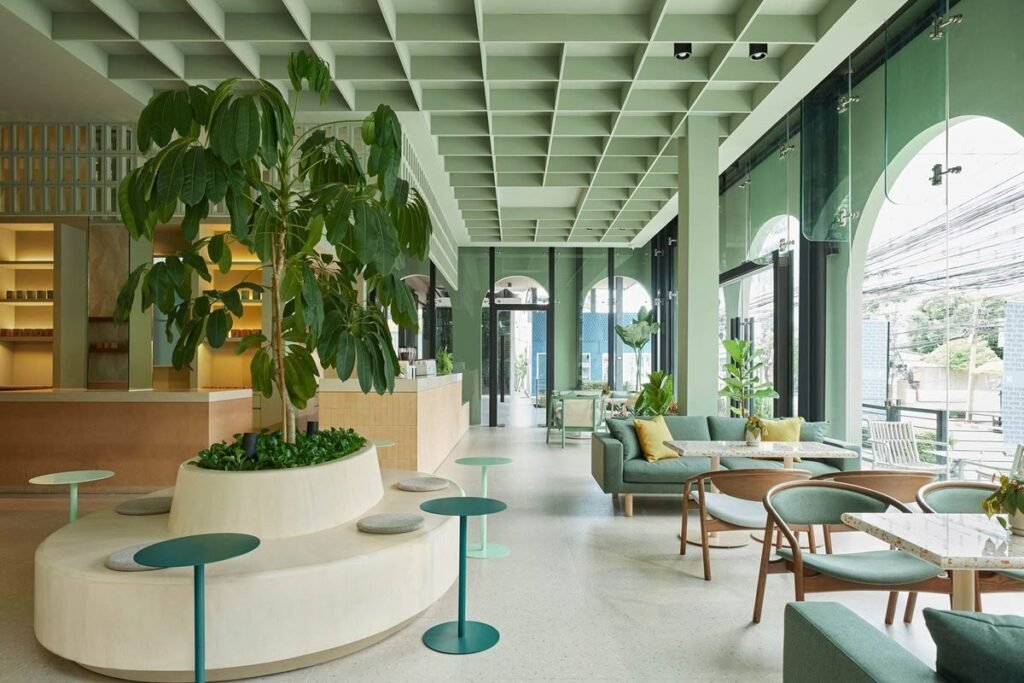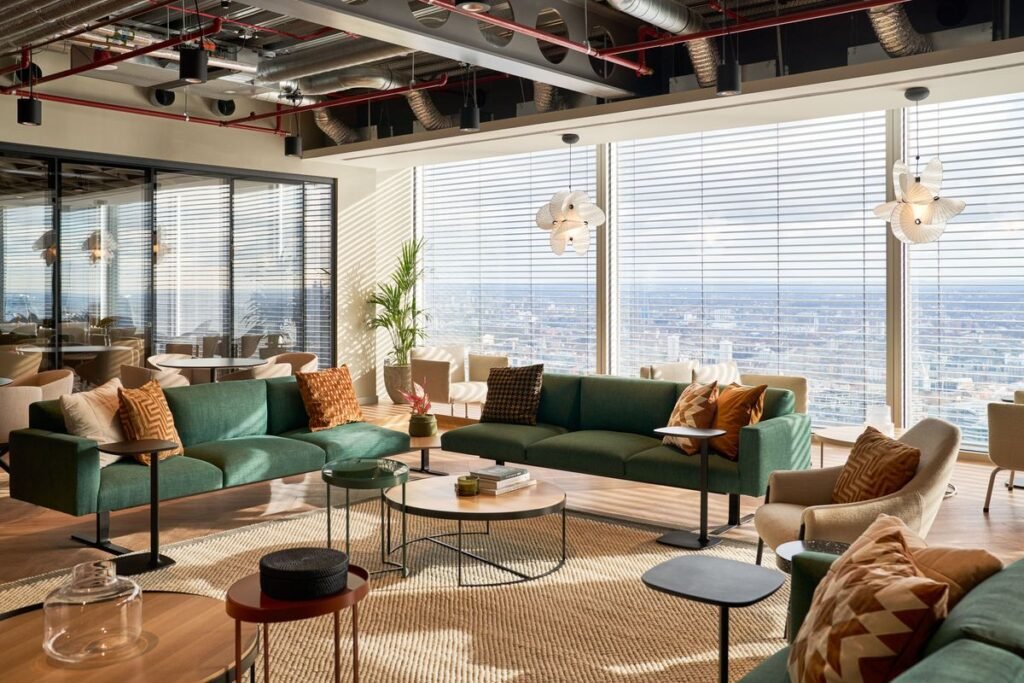Meta Description
Discover how interior design shapes company culture and branding with modern decor, luxury interiors, and stylish upgrades that leave a lasting impression.

Introduction
How interior design shapes company culture and branding is more than a question of style—it’s a statement of purpose. The way an office is designed communicates a company’s values before a single word is spoken. From modern decor that inspires collaboration to bespoke furniture that reflects prestige, every element influences how employees feel and how clients perceive the brand. When executed with vision and refinement, luxury interiors create an environment where culture thrives and branding becomes tangible.
The Power of Design in Defining Company Culture
Office interiors act as silent ambassadors of a company’s culture. The atmosphere they create speaks volumes about the organization’s priorities, aspirations, and work ethic.
Employee Morale and Productivity
A thoughtfully designed office can boost morale, encourage teamwork, and even reduce stress. Open-plan living concepts, paired with architectural details like glass partitions, foster transparency while maintaining structure. Natural elements such as greenery and wood finishes provide calmness, improving focus and well-being.
Reinforcing Values through Space
When interiors echo a company’s mission, employees feel connected to its vision. For instance, a firm promoting innovation may benefit from flexible zones with textured fabrics, movable partitions, and statement lighting—spaces that energize creativity and embrace adaptability.
Branding Beyond Logos: Design as Identity
Branding is not limited to logos or color schemes; it is embodied in how people experience a space. Luxury interiors communicate credibility, refinement, and prestige—qualities no brochure alone can convey.
First Impressions That Last
Reception areas with bespoke furniture and elegant finishes create a memorable arrival. Designer touches such as textured walls or curated art pieces demonstrate attention to detail, signaling professionalism and exclusivity.
Consistency Across Touchpoints
When design ideas align with corporate branding, the result is cohesion. From boardrooms to breakout lounges, a consistent aesthetic ensures that employees and clients encounter the same story: a narrative told not only through visuals but also through ambience.
Stylish Upgrades That Transform Workplaces
Updating interiors is not always about grand renovations—sometimes it’s about making deliberate, stylish upgrades that redefine spaces without disrupting operations.
- Statement Lighting: Layered lighting plans balance task efficiency with visual drama, reinforcing brand personality.
- Bespoke Furniture: Tailored pieces highlight craftsmanship and distinguish a company’s taste from mass-produced alternatives.
- Textured Fabrics: Upholstery in rich textiles adds depth and warmth, encouraging comfort during long hours of collaboration.
- Natural Elements: Marble accents, wooden panels, or living walls weave in a timeless sense of balance.
These design ideas illustrate how even subtle interventions can reinforce culture and branding while maintaining a professional environment.
Architectural Details as Strategic Tools
Luxury interiors are not only about beauty; they are strategic assets. Consider how architectural details guide movement, interaction, and perception within an office.
- Circulation Patterns: Wide corridors and strategically placed meeting hubs encourage chance encounters, fostering cross-department collaboration.
- Zoning with Purpose: Quiet pods for focused work, open lounges for brainstorming, and executive suites for leadership—all reflect organizational priorities.
- Showcasing Innovation: Transparent meeting rooms or glass staircases highlight values of openness, ambition, and forward-thinking leadership.
By blending form and function, architectural choices communicate the soul of the brand.
How Interior Design Shapes Company Culture and Branding
At its core, design is storytelling. It communicates values not through slogans but through spatial experiences. Employees internalize culture when they work in an environment that mirrors their company’s ambitions, while clients recognize branding when they see consistency and elegance woven into every corner. From stylish upgrades to sweeping transformations, modern decor and luxury interiors prove that the right design is the most persuasive brand ambassador.
Conclusion
How interior design shapes company culture and branding is clear: offices designed with vision and refinement inspire employees, impress clients, and embody brand identity. At Good House Interiors, we specialize in creating elegant finishes, bespoke furniture, and architectural details that elevate every workspace into a cultural and branding statement. To explore our expertise in space planning, office design, or custom furniture solutions, contact us today and let your interiors speak for your brand.
FAQs
Q1: How can office design influence employee engagement?
A well-planned interior with natural elements, open layouts, and designer touches fosters transparency, reduces stress, and encourages collaboration, directly enhancing engagement.
Q2: What role does luxury interior design play in corporate branding?
Luxury interiors act as a tangible extension of brand identity, showcasing professionalism and exclusivity through bespoke furniture, statement lighting, and elegant finishes.
Q3: Are stylish upgrades enough to impact company culture?
Yes. Simple yet strategic upgrades—like textured fabrics, natural elements, or architectural details—can significantly elevate workplace atmosphere and reinforce culture.
Q4: How do architectural details support productivity?
Features such as soundproof pods, circulation pathways, and glass partitions balance privacy with collaboration, enabling employees to work effectively while embodying brand values.
Q5: Can modern decor and branding coexist in a corporate setting?
Absolutely. Modern decor, when thoughtfully curated, blends with corporate branding by emphasizing clean lines, open-plan living, and timeless designer touches that align with company identity.

كيف يشكل التصميم الداخلي ثقافة الشركة والعلامة التجارية
كيف يشكل التصميم الداخلي ثقافة الشركة والعلامة التجارية ليس مجرد سؤال عن الذوق — إنه إعلان لهوية. طريقة تصميم المكتب تُبلِّغ عن قيم المؤسسة قبل أن تُقال كلمة واحدة. من الديكور الحديث الذي يحفز التعاون إلى الأثاث حسب الطلب الذي يعكس مكانة راقية، كل عنصر يؤثر على شعور الموظفين وانطباع العملاء. عندما يُنفّذ التصميم برؤية رفيعة، تتحول الديكورات الفاخرة إلى بيئة تزدهر فيها الثقافة وتصبح العلامة التجارية ملموسة.
قوة التصميم في تحديد ثقافة الشركة
تؤدي الديكورات المكتبية دور السفير الصامت لثقافة الشركة. الأجواء المبنية داخل المساحة تبوح بأولويات المؤسسة وطموحاتها وأخلاقيات العمل.
المعنويات والإنتاجية
مكتب مُصمَّم بعناية يرفع المعنويات، ويشجع العمل الجماعي، ويقلل التوتر. مفاهيم المساحات المفتوحة مع التفاصيل المعمارية مثل الحواجز الزجاجية تعزز الشفافية مع الحفاظ على بنية واضحة. إدخال عناصر طبيعية كالخضرة والتشطيبات الخشبية يمنح هدوءًا يعزّز التركيز والرفاهية.
ترسيخ القيم عبر المساحة
عندما تعكس الديكورات رسالة الشركة، يشعر الموظفون بأنهم جزء من الرؤية. على سبيل المثال، شركة تعزز الابتكار تستفيد من مناطق مرنة بخصوصية قابلة للتعديل، أقمشة ذات قوام، وحواجز متحركة، إضافة إلى إضاءة ملفتة — مساحات تُشعل الإبداع وتستوعب المرونة.
العلامة التجارية تتجاوز الشعار: التصميم كهوية
العلامة التجارية ليست مجرد شعار أو لوحة ألوان؛ إنها تجربة المكان. تُعبّر الديكورات الفاخرة عن المصداقية والرقي والمكانة — صفات لا يمكن لكتيب تسويقي أن ينقلها بمفرده.
انطباعات أولى تدوم
مناطق الاستقبال المزدانة بأثاث حسب الطلب وتشطيبات أنيقة تخلق دخولاً لا يُنسى. لمسات المصمم مثل جداريات ذات ملمس أو قطع فنية مُنسقة تبرز الحرص على التفاصيل، ما يدل على الاحترافية والحصرية.
اتساق عبر نقاط التماس
عندما تتوافق أفكار التصميم مع هوية العلامة التجارية، تتولد وحدة سردية. من قاعات الاجتماعات إلى صالات الاستراحة، يواجه الموظف والعميل نفس السرد: قصة تُحكى ليس فقط بصريًا بل عبر الجو العام.
تحديثات أنيقة تُحوّل أماكن العمل
التجديد لا يتطلب دائماً هدمًا شاملاً؛ أحيانًا يكفي إجراء تحديثات أنيقة مدروسة تعيد تعريف الفضاء دون تعطيل سير العمل.
- إضاءة ملفتة: خطط إضاءة متعددة المستويات توازن بين الكفاءة والدراما البصرية لتعزيز شخصية العلامة التجارية.
- أثاث حسب الطلب: قطع مُفصلة تبرز الحرفية وتُميّز ذوق الشركة عن البدائل الجاهزة.
- أقمشة محبكة/قوامية: تنجيد بأقمشة فاخرة يضيف عمقًا ودفئًا، ما يجعل أماكن التعاون أكثر راحة.
- عناصر طبيعية: لمسات من الرخام، ألواح خشبية، أو جدران خضراء تُدخِل توازنًا خالدًا.
تُبيّن هذه أفكار التصميم كيف أن التدخلات البسيطة قد تُعزّز الثقافة والهوية دون المساس بمهنية المكان.
التفاصيل المعمارية كأدوات استراتيجية
الديكورات الفاخرة ليست مجرد جمال، بل أصول استراتيجية. فكر كيف تُوجّه التفاصيل المعمارية حركة الناس وتفاعلاتهم وانطباعاتهم داخل المكتب.
أنماط الحركة
ممرات واسعة ومراكز اجتماع موضوعة بعناية تشجع اللقاءات العفوية، فتحفز التعاون بين الأقسام.
تقسيم المناطق بهدف
حجرات هادئة للعمل المركز، صالات مفتوحة للعصف الذهني، وأجنحة تنفيذية للقيادة — كلها تُظهِر أولويات المنظمة بصورة بصرية.
عرض الابتكار
غرف اجتماعات شفافة أو سلالم زجاجية تُبرز قيم الانفتاح والطموح والقيادة المتطلعة للمستقبل.
بدمج الشكل مع الوظيفة، تُعلِن الخيارات المعمارية عن روح العلامة التجارية.
كيف يشكل التصميم الداخلي ثقافة الشركة والعلامة التجارية
جوهر التصميم هو السرد. يُبلّغ عن القيم ليس بشعارات بل بتجارب مكانية. يستوعب الموظفون الثقافة حين يعملون في بيئة تعكس طموحات الشركة، ويتعرف العملاء على العلامة التجارية حين يرون الاتساق والأناقة في كل زاوية. من تحديثات أنيقة إلى تحوّلات جذرية، يبرهن الديكور الحديث والديكورات الفاخرة أن التصميم المناسب هو أقوى سفير للعلامة.
كيف يشكل التصميم الداخلي ثقافة الشركة والعلامة التجارية واضح: المكاتب المصمَّمة برؤية وذوق تُلهِم الموظفين، وتثير إعجاب العملاء، وتجسد هوية العلامة. في Good House Interiors، نختصّ في خلق تشطيبات أنيقة، أثاث حسب الطلب، وتفاصيل معمارية ترفع كل مساحة عمل إلى بيان ثقافي وهوية علامة. لاستكشاف خدماتنا في تخطيط المساحات، تصميم المكاتب أو تصميم غرفة المعيشة (إن طُلب ذلك في مشاريع مخصصة)، تواصل معنا اليوم ودع مساحاتك تتكلم نيابة عن علامتك.
الأسئلة الشائعة حول تصميم مناطق الإنتاج والتجميع
س1: كيف يؤثر التصميم على كفاءة منطقة الإنتاج / التجميع؟
تصميم جيد لمسارات العمل، نقاط الإمداد، والإضاءة التشغيلية يقلل زمن النقل الداخلي ويُحسّن الإركان (ergonomics)، ما يرفع الكفاءة ويقلل الأخطاء.
س2: ما عناصر التصميم الحيوية في مناطق الإنتاج؟
عناصر مثل مخططات سير العمل الواضحة، إضاءة مهمة ومُعيارية، تشطيبات سهلة التنظيف، وحلول أثاث قابلة للتعديل تضمن سلامة وكفاءة التشغيل.
س3: هل يمكن دمج لمسات فاخرة في مناطق الإنتاج دون المساس بالعملية؟
نعم—يمكن اعتماد تشطيبات متينة بلمسات مصمم، إضاءة بيانية، ومناطق استقبال مصممة تُعكس صورة العلامة دون التأثير على الأداء الصناعي.
س4: كيف نُراعي السلامة عند تصميم مناطق التجميع؟
الابتعاد عن المواد الزلقة، وضع مسارات هروب واضحة، استخدام إضاءة مهام مناسبة ووضع علامات اتجاهية يندرج تحت متطلبات التصميم الآمن والمتوافق مع معايير التشغيل.
س5: ما دور الأثاث حسب الطلب في خطوط الإنتاج؟
الأثاث المصمم خصيصًا يوفّر توافقًا مثاليًا مع احتياجات العملية—محطات عمل قابلة للتعديل، تخزين متناغم، وحلول مساحات تقلل من الازدواجية وتحسّن انسيابية العمل.
